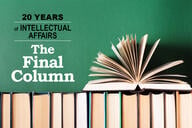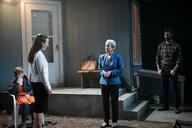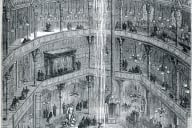You have /5 articles left.
Sign up for a free account or log in.
Harvard University Press has just issued a book promulgating a JFK assassination conspiracy theory.
Let's put that sentence on the chalkboard and underscore the anthropologically interesting aspects of the situation, shall we? Harvard University Press has just issued a book promulgating a JFK assassination conspiracy theory.
Within the continuum of any given culture, there is what the structuralists used to call the combinatoire – the underlying grid of distinctions and exclusions, an implicit directory of what goes with what (and, just as important, what doesn’t). So the appearance of The Road to Dallas: The Assassination of John F. Kennedy by David Kaiser counts, arguably, as something more than a piece of publishing news. That, too. But we may be talking here about something like a mutation in the cultural genome.
That said, the book’s argument does not exactly qualify as a paradigm shift. Kaiser, who is a professor of strategy and policy at the Naval War College and the author of two earlier books published by Harvard, argues that Lee Harvey Oswald pulled the trigger as a result of machinations within “a complex network of relationships among mobsters, hit men, intelligence agents, Cuban exiles, and America’s Cold War foreign policy.” To make this case, Kaiser examines an enormous mass of documents that have been declassified since 1992. “Hundreds of books on the Kennedy assassination have appeared,” he writes, “but this is the first one written by a professional historian who has researched the available archives.” Perhaps, but it is also a variation on certain familiar themes.
For an academic to take a deep interest in JFK conspiracy theories is unusual but hardly unprecedented. One of the very first books in the genre was Six Seconds in Dallas: A Micro-Study of the Kennedy Assassination (1967), the work of a philosopher named Josiah Thompson, who later achieved tenure at Haverford College on the basis of his scholarly work concerning Soren Kierkegaard’s existentialist writings. In the mid-1970s, Thompson turned his back on academic life and became a private detective. As career changes go, it seems the stuff of daydreams.
Over the decade following Thompson’s pioneering “micro-study,” research into JFK conspiratology turned into an almost professionalized field of inquiry – even if those pursuing it tended to be amateurs, not to say hobbyists. By the late 1970s, eager new conspiracy theorists were warned by their elders not to try to master the entire discipline. Instead, they should choose some overlooked corner of the assassination (“who was Oswald's landlady really?” perhaps) and become the recognized expert on it. Sound familiar?
“Publish or perish” seems to have kicked in as well. So I discovered in 1991 while working as an archival technician at the Library of Congress. The extent of the LC’s holdings can be overwhelming to confront – more than 500 miles of shelves, with books overflowing them and accumulating in the aisles. The stacks can induce an experience that feels rather like what Kant called “the mathematical sublime.” This is the feeling of being shaken by the sheer magnitude of a natural phenomenon that is far more enormous than anything you can quite wrap your mind around. Trying to imagine just how vast a galaxy must be, given that we fill just one small part of a single solar system, for example, gives a taste of the mathematical sublime.
By that standard, perhaps, the library stacks are not quite cosmically mindblowing. Still, it’s probably for the best that they are off limits to the public, which might otherwise wander them in a total daze.
After a while, you learn out the bookish sublime. But I blundered right into another version of it one day, thanks to an aisle located on one floor loaded with U.S. history titles. One end of the aisle was dominated by the original edition of the complete Warren Commission Report. This was for many years the mother lode of all debate and conjecture on the Kennedy assassination. It runs to 26 volumes, and there were two full sets. The spines told of heavy use.
They were an impressive sight. But more overwhelming was the next row of books – and the row after that, then the row after that. Volume after volume (running to the hundreds) lingered over the events of that day in November 1963, analyzing every aspect of the event you could imagine, and some you probably couldn’t. Overlooked suspects were named. Their means, motives, and opportunities were documented at length. The official account was refuted, again and again; and the theorists debunked one another, as well.
It was hard to take in, not just how prolific the conspiracy people were, but how thoroughly their attention had absorbed every possible detail from the record – extracting meanings from it, but diverse and contradictory meanings. Each fact fed several interpretations. Every interpretation generated suspicion. Which meant, in turn, more research and theorizing – more facts, and more analysis, and more suspicion. The question of who killed JFK, and why, was clearly inexhaustible. Or at least the passion for reopening the question was. It seemed bottomless, like an abyss.
This was scholarship, of a kind. But it tended not be cumulative. No synthesis could ever reconcile all of the arguments, or even most of them. (Only the intrepid reporters at The Onion have ever come close.) The conspiracy researchers formed a community, yet their theories were monads.
Later, I found out that Josiah Thompson had published a book about Soren Kierkegaard’s pseudonymous writings on faith and solitude at the very same time his Six Seconds in Dallas appeared. The title of his monograph was The Lonely Labyrinth – a really perfect description, too, of the world within those hundreds of JFK volumes.
How is it that the latest gallery within the labyrinth is a book published by Harvard University Press? Why did one of the country’s most distinguished scholarly publishers decide to contribute to a genre that has flourished mainly on the cultural margins for almost five decades?
This line of inquiry interested me a lot more than the one pursued by David Kaiser in The Road to Dallas. I mean no disrespect to the author. His previous works of scholarship – a macrohistorical account of European warfare and a study of American policy during the Vietnam conflict – have been well received by his colleagues. And The Road to Dallas is a sober book, with none of the fervid whirligigs of logic found in some other titles in the field, even by academics.
But it is a work of conspiracy theory, all the same. It follows some of the familiar protocols of the genre. Kaiser examines documents that were released in the wake of Oliver Stone’s "JFK" – a film he calls irresponsible, but important for creating pressure on the government to declassify thousands of records. And there is the standard “Cui bono?” clincher. Who benefited? For Stone, it was LBJ and the military-industrial complex. For Kaiser, the answer is equally clear: “The killing of President Kennedy, followed by the resignation less than a year later of Robert Kennedy as attorney general, seriously curtailed the government’s effort to clean up organized crime – as it was intended to do.”
But the idea that some new mass of evidence will solve the mystery once and for all is what has kept the whole conspiratological process going all these years. Finality is not the name of this game. New charges of concealment will always double back upon any supposed revelation. “The Central Intelligence Agency has nothing to do with Kennedy’s assassination,” wrotes Kaiser, despite its extensive involvement with both organized crime and its attempts to kill Fidel Castro (or at very least deprive him of the power associated with his beard). You can imagine how other conspiracy theorists, academic or otherwise, will pick over that argument – especially given that the author is a professor at the Naval War College.
So, again, how did Harvard University Press end up giving its imprimatur to a work embedded in this particular (and rather off-beat) discursive formation? It was once the case that JFK conspiracy books tended to be self-published, or sold by presses specializing in exotica. Certainly the vast majority of those from the 1970s and ‘80s that I saw on the shelves at the Library of Congress were. Commercial publishers have issued a few, given the niche market.
But it seemed as if some kind of threshold were being crossed when such a title was announced in the pages of The New York Review of Books, via an ad from Harvard. When a colleague pointed this out by e-mail, only one piece of digital shorthand seemed to apply: WTF?
Following a little sleuthing, I was directed to Kathleen McDermott. She is identified in the acknowledgments to The Road to Dallas as one of the editors at Harvard University Press who “embraced the idea and did a great deal to make the final product read more clearly.” We had some exchanges by phone and by e-mail last week, but I must confess to being more perplexed now than when I began.
What was the decision-making process behind acquiring this book like? Was there any concern about the idea of lending the press’s enormous cultural authority to a work of conspiracy theorizing? Did anyone there express reservations? Was there, perhaps, something in particular about the evidence or analysis that seemed to make publishing such a volume worth the risk?
They knew that a book on the JFK assassination might be controversial, McDermott told me by phone. “For that very reason, it was attractive and appealing,” she said. The press had signed him up for the book while he was still involved in the research and had not yet finished the manuscript. This struck me as a rather remarkable expression of confidence given the nature of the material. So I asked if it was simply a matter of him having credit, so to speak, given the favorable reception of Kaiser’s earlier scholarship.
“Partly it was a matter that we knew him,” said McDermott. “And partly it was because this is a topic that engages people so emotionally that to have a book like this come out from the press seemed worthwhile. People do like to read this kind of information. People live for these details, and we wanted to be able to present a detailed examination of the case.”
Between the lines of that answer, it sounded as if the potential market for such a book were a big factor. Now, I do try to be a realist. For a struggling academic press to turn out cookbooks and guides to state flowers seems like a reasonable price to pay, if it means good scholarly books are also in the catalog. But implicit in that trade-off, it seems, is the need for a kind of Chinese wall between the kinds of books. The process of accepting and publishing a scholarly work ought to take shape primarily (in the best of all possible worlds, exclusively) with reference to intellectual standards. If it sells outside the community of scholars, great. But a kind of stern lucidity about the distinction between kinds of books seems worth maintaining in principle, however difficult that may be in practice.
So I wondered aloud if McDermott's mention of “people [who] like to read this kind of information” didn’t imply that the decision to publish The Road to Dallas was primarily market-driven. “Certainly we were aware of the possibility of reaching a wide audience,” she said. “That was not the sole reason, but part of a lot of connected reasons to do it.”
After hanging up the phone, I thought of an obvious topic to have discussed. What sort of peer review did the book have? How many scholars had vetted the manuscript? By any chance would it be possible for me to get look at the reviews they had written for the press? I sent her an email note posing these questions.
“Let me just reiterate,” McDermott responded, “that the book went through a standard acquisition process at the press. It was seen from first consideration as a serious history book by a serious historian.”
Fair enough! But to someone who doesn’t know the exact details of the standard acquisition process at Harvard University Press, that answer leaves unclear just how The Road to Dallas was peer-reviewed. So I wrote back to ask. In particular, I wanted to know just how many scholars had been asked to go over the book before it was approved for publication.
No answer came. I decided to wait until the start of the new week to ask again. And when still no response was forthcoming, something dawned on me. I'd prefer not to think it, but it can't be helped: Evidently there are certain mysteries for which cynical speculation proves unavoidable.




